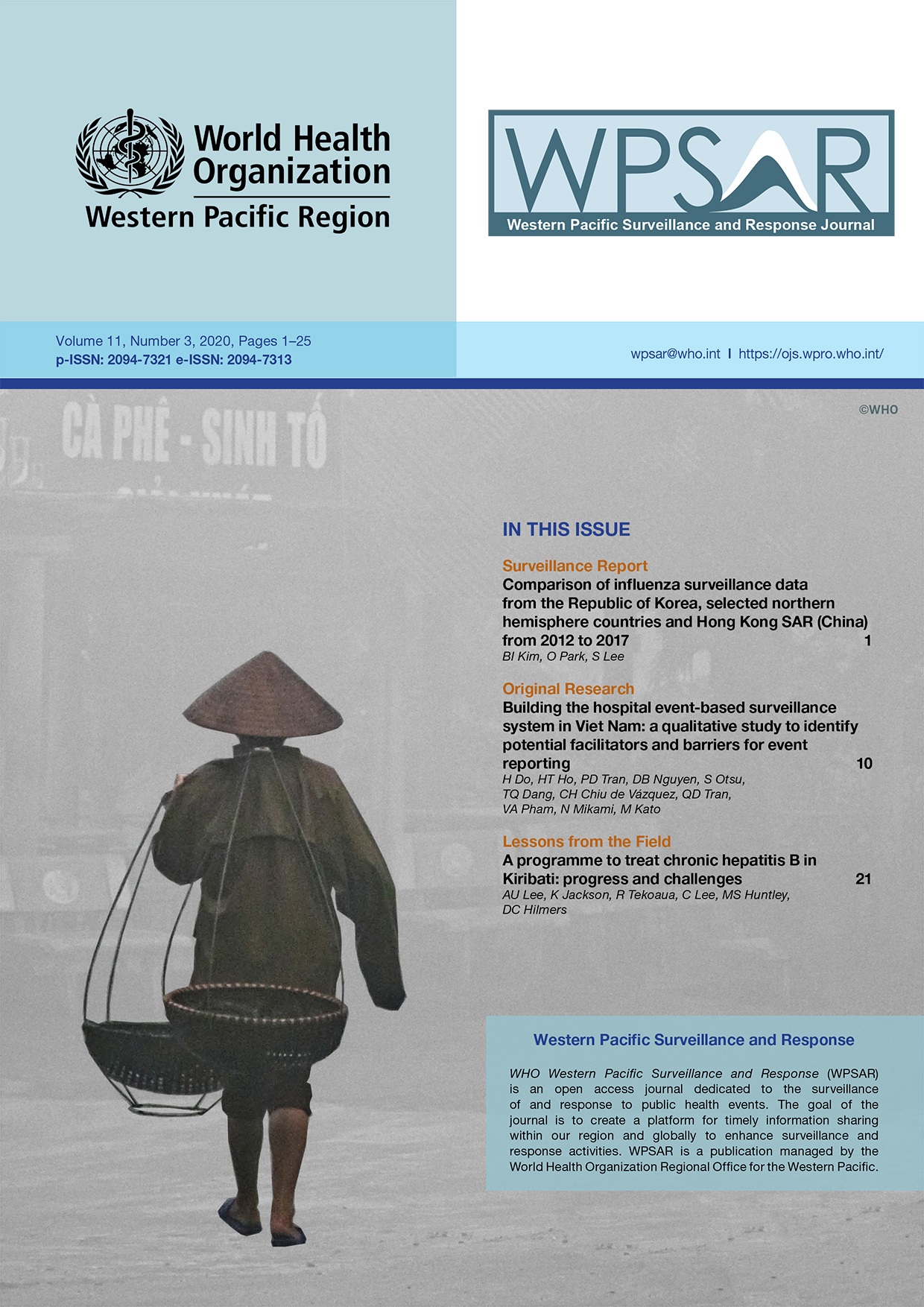A programme to treat chronic hepatitis B in Kiribati: progress and challenges
DOI:
https://doi.org/10.5365/wpsar.2019.10.4.003Abstract
Problem: Over 290 million people worldwide suffer from chronic hepatitis B (CHB), with the highest prevalence in the Pacific islands. Mortality attributable to this disease exceeds that from HIV, tuberculosis and malaria combined in this region.
Context: CHB is a major health problem in the Pacific island nation of Kiribati. Medical care is complicated by vast expanses of ocean separating population centres in its constituent islands. Birth-dose hepatitis B immunization rates need improvement. High rates of obesity, metabolic syndrome, and co-infection with hepatitis B and hepatitis D in Kiribati make treatment less effective. Staff allocation, training and retention are difficult. Limited infrastructure creates challenges in training, communications, laboratory testing and record-keeping.
Action: We have established a CHB treatment programme in Kiribati based on World Health Organization (WHO) guidelines and local needs. It includes direct patient care; laboratory, radiology and pharmacy support; public education; training; and data management. Thousands of individuals have been screened, and 845 hepatitis B-positive patients have had blood sent to Australia for molecular testing. Patient education pamphlets, medical training programmes and treatment protocols have been developed. Seventy-nine patients have started treatment. Regular onsite visits by technical experts are scheduled throughout the year.
Lessons learnt and discussion: This is the first national CHB treatment programme established in the Pacific islands region. Unique challenges exist in Kiribati, as they do in each nation affected by CHB. Close engagement with local partners, knowledge of the barriers involved, flexibility, advocacy, and support from WHO and volunteer technical experts are key attributes of a successful treatment programme.
References
Polaris Observatory Collaborators. Global prevalence, treatment, and prevention of hepatitis B virus infection in 2016: a modelling study. Lancet Gastroenterol Hepatol. 2018 Jun;3(6):383-403. doi: 10.1016/S2468-1253(18)30056-6. Epub 2018 Mar 27.
WHO Global Hepatitis Report, 2017. https://www.who.int/hepatitis/publications/global-hepatitis-report2017/en/. Accessed 15 March 2019.
World Health Organization. Global health sector strategy on viral hepatitis 2016-2021. Towards ending viral hepatitis. World Health Organization; 2016. https://www.who.int/hepatitis/strategy2016-2021/ghss-hep/en/. Accessed 15 March 2019.
Wilson N, Ruff TA, Rana BJ, Leydon J, Locarnini S. The effectiveness of the infant hepatitis B immunisation program in Fiji, Kiribati, Tonga and Vanuatu. Vaccine 2000;18:3059–66.
McIver L, Woodward A, Davies S, Tibwe T & Iddings S (2014). Assessment of the health impacts of climate change in Kiribati. International Journal of environmental research and public health, 11(5), 5224-5240, doi: 10.3390/ijerph110505224
UNAIDS Country Data 2017. http://www.unaids.org/en/regionscountries/countries/papuanewguinea. Accessed 15 March 2019
WHO Viral Hepatitis Situation and Response in Kiribati. apps.who.int/iris/rest/bitstreams/1147878/retrieve Accessed 18 March 2019
Krause A, Haberkorn U, Mier W. Strategies for the treatment of HBV/HDV. Eur J Pharmacol. 2018 Aug 15;833:379-391. doi: 10.1016/j.ejphar.2018.06.030. Epub 2018 Jun 21.
Guidelines for the Prevention, Care and Treatment of Persons with Chronic Hepatitis B Infection. Geneva: World Health Organization; 2015 Mar. PubMed PMID: 26225396.
Yurdaydin C. New treatment options for delta virus: Is a cure in sight? J Viral Hepat. 2019 Feb 16. doi: 10.1111/jvh.13081. [Epub ahead of print] Review.
Lin Y, Liu Y, Ding G, Touqui L, Wang W, Xu N, Liu K, Zhang L, Chen D, Wu Y, Bai G. Efficacy of tenofovir in preventing perinatal transmission of HBV infection in pregnant women with high viral loads. Sci Rep. 2018 Oct 19;8(1):15514. doi: 10.1038/s41598-018-33833-w

